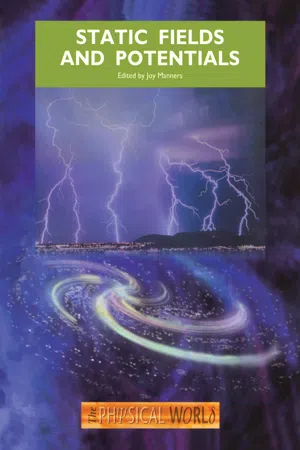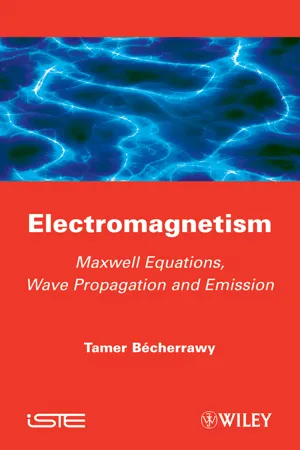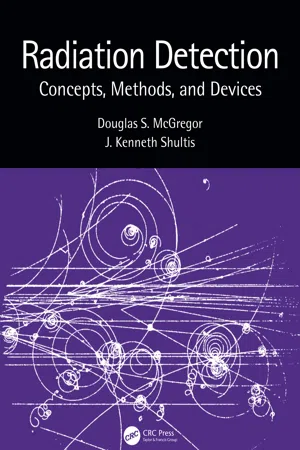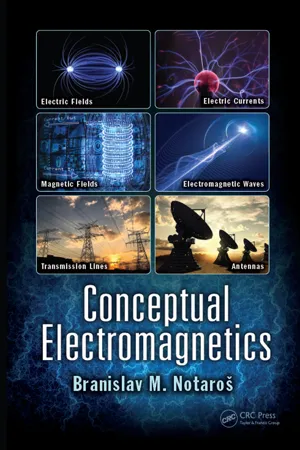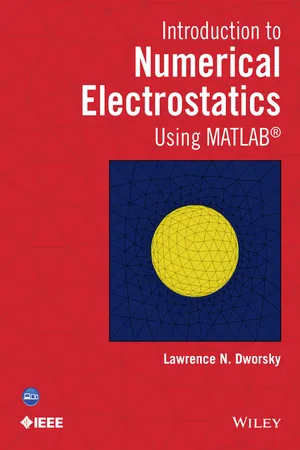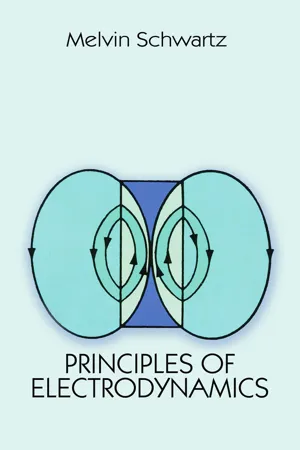Physics
Electrostatic Potential Energy
Electrostatic potential energy is the energy stored in a system of charged particles due to their positions relative to each other. It is directly related to the amount of work required to assemble the system of charges. The formula for electrostatic potential energy is U = k * (q1 * q2) / r, where U is the potential energy, k is Coulomb's constant, q1 and q2 are the charges, and r is the distance between the charges.
Written by Perlego with AI-assistance
Related key terms
Related key terms
1 of 4
Related key terms
1 of 3
11 Key excerpts on "Electrostatic Potential Energy"
- eBook - ePub
Dielectrophoresis
Theory, Methodology and Biological Applications
- Ronald R. Pethig(Author)
- 2017(Publication Date)
- Wiley(Publisher)
An approaching electrophile will tend to head towards those surface regions of the molecule where V (r) attains its most negative values (i.e., local minima of the electrostatic surface) because this is where the molecule's electrons are most dominant and potentially available to form valence bonds with other atoms. 4.4 Electrostatic Field Energy From Equation (4.16) the electrical potential (defined as the potential energy per unit charge) at a point in an electrical field is equal to the work done against the field E in bringing a unit charge from infinity to that point. We can thus write the energy of a point charge q 2 in the field of a single point charge q 1 as: where V 21 is the potential at q 2 due to q 1. We can also say that the potential is equal to the work returned by the system as one of these charges is taken back to infinity. The two charges therefore have a mutual and reciprocal energy, so that Bringing another charge q 3 into the field increases the energy: The mutual energies of charge pairs also allow us to express this as: Extending this logic to a complete and closed system of n charges: where V i is the potential q i due to the remaining n − 1 charges in the closed system. If we designate V o as the potential arising from the charges being uniformly distributed with a volume density ρ throughout a dielectric, the energy can be expressed as a volume integral: (4.31) This integral must be carried out over a volume that encloses all of the charge. Charges are rarely distributed throughout the bulk volume of a dielectric, but appear as a surface charge density σ on conductors that form, for example, the electrodes of a capacitor. In this case the increase in the potential energy of the field results from work done by the electromotive force of a battery in building up this surface charge and can be evaluated from a surface integral of the form: Stratton [3, p - eBook - ePub
Molecular Driving Forces
Statistical Thermodynamics in Biology, Chemistry, Physics, and Nanoscience
- Ken Dill, Sarina Bromberg(Authors)
- 2010(Publication Date)
- Garland Science(Publisher)
21 The Electrostatic Potential We Switch from Fields (Forces) to Electrostatic Potentials (Energies)The electrostatic field, introduced in Chapter 20 , describes forces, which are vector quantities. In this chapter, we switch to the electrostatic potential, which describes energies, which are scalar quantities. We switch for two reasons. First, scalars are easier to use than vectors. Second, our aim in Chapters 22 and 23 is to predict equilibria in systems in which charges play a role. To predict equilibria, we need energies.We also develop here Poisson’s equation. Poisson’s equation simplifies electrostatics calculations in many problems. We will use it in Chapter 22 to compute the energy for moving a charged particle, such as a salt ion or protein, in the vicinity of other charged objects such as proteins, colloids, DNA, polyelectrolytes, membranes, electrodes, or dielectric boundaries.What Is the Electrostatic Potential?The work dw that you must perform to move a charge q through a small distance dℓ in the presence of a fixed electrostatic field E is the negative of the dot product of the force f = qE and the displacement dℓ (see Equation (3.8) ):δ w = − f ⋅ d ℓ = − q E ⋅ d ℓ .(21.1) There is a minus sign in Equation (21.1) because this work is performed against the field, not by the field as in Equation (3.8) . To move a charge from point A to B, the total work wAB is given by the path integral (see Appendix G ),w= − qA Bℓ .∫ A BE ⋅ d(21.2) By equating wAB with the electrostatic energy, we are assuming, according to the First Law of Thermodynamics, processes that involve no heat exchange. In such cases, wAB is the maximum possible work and is called the reversible work - eBook - ePub
- Joy Manners(Author)
- 2020(Publication Date)
- CRC Press(Publisher)
V may be positive or negative depending on whether the potential increases or decreases along the direction being considered.In Chapter 1 , you saw that when charge is placed on a body, an electric field is produced in the region around the body. The electric field in turn makes it harder to place more charge of the same sign on the body. Thus, energy is required to establish any particular charge distribution, and this energy can be recovered by allowing charges of opposite sign to be attracted to the charge distribution and neutralize it. As the energy used in establishing a charge distribution is recoverable, it may be described as stored energy. In the rest of this section, you will see how capacitors store Electrostatic Potential Energy by maintaining a separation of positive and negative charges.4.1 Capacitors
The electric potential of a conductor is related to the amount of charge residing on it. The more positive charge there is on a body, the more energy is required to bring up extra positive charge and deposit it on the body.Many electrical circuits contain devices whose primary function is to store energy by separating charge in the circuit. Such devices are called capacitors. A commonly used type of capacitor is the parallel plate capacitor. In its simplest form, this consists of two parallel, conducting plates, each of area A and separated by a distance d, in a vacuum (Figure 2.21 ). A charge q is transferred to one plate and a charge of the same magnitude and the opposite sign is transferred to the other, resulting in a potential difference V between the plates. The ratio of the charge on either of the plates to the potential of that plate relative to the other plate, is called the capacitance of the capacitor, and is denoted by the letter C:C =(2.22)q V.Note that if q is positive, V is also positive, whereas if q is negative, V is negative. The capacitance is, therefore, always positive. Capacitance is a constant that depends on the geometry and materials of the capacitor but is itself independent of the charge q and potential difference V, - No longer available |Learn more
- Robert A. Pelcovits, Joshua Farkas(Authors)
- 2023(Publication Date)
- Barrons Educational Services(Publisher)
Therefore, the charges on the sphere rearrange so that the negative charge is closer to + Q than the positive charge. Because the electrostatic force is inversely proportional to (distance) 2, this causes the attraction between + Q and the negative charge on the sphere to be greater than the repulsion between + Q and the positive charge on the sphere, giving rise to a net attractive force. The magnitude of this force depends on the magnitude of + Q and the degree to which charges can move around on the sphere. Potential and Voltage The Definitions of Potential and Voltage Recall from universal gravitation that we introduced a potential energy function U (x) associated with a system of particles as a function of their relative position (e.g., U (r) = − Gm 1 m 2 / r). It would be perfectly valid to develop an analogous potential energy function associated with the electrostatic force. However, this U (x) function would only tell us about the potential energy of a particular set of charges. It would be more useful to somehow generalize U (x) so that it could tell us about the potential energy of a charge of any value in the presence of a set of source charges (the same way the electric field allows us to quickly calculate the force on a charge of any value using the equation F = Q E and the gravitational field allows us to quickly calculate the force on a mass of any value). Because U (x) is obtained by integrating force and because force is proportional to the magnitude of the test charge, U (x) is also proportional to the charge of the test charge. Thus, the ratio between U (x) and the charge is independent of the value of the charge, and we can define electric potential V (a scalar quantity) as this ratio: If we define potential as above, we can easily calculate the potential energy U of a charge of any value simply by multiplying the value of the charge by potential - eBook - ePub
- Michael Pycraft Hughes(Author)
- 2018(Publication Date)
- CRC Press(Publisher)
Equation 2.4 ; that is, the electric field is the differential (i.e., the gradient) of the potential. An analogy is that of a gravitational field; if one considers the gravity field generated by the Earth, then the potential is equivalent to the height above the center of the earth, and the electric field is equivalent to the gradient of the surface. A particle (e.g., a ball) placed on the surface of the earth (such as a hill) will roll down the hill in the same manner as a charge being attracted toward a much larger charge in electrostatics, moving between two potentials in the process. When illustrating the potential we often use equipotential lines — these follow the contours of equal voltage and always intersect the field lines due to the same charges at right angles.Figure 2.3 Electric field lines are diverted by the presence of other charges; here we see how the field lines are (a) bent toward one another when the charges have opposite sign and (b) repelled when the charges have the same sign.Since the electrostatic potential varies in three dimensions, it is necessary to determine the gradient in each direction in order to derive the appropriate vectors. If we consider the movement of a unit charge along a small vector distance dl, then that distance dl can be expressed in terms of three unit vectors:
Similarly, we can express the electric field at that point in terms of its three vector components:d l = i d x + k d y + k d z(2.5) E = iE x+ jE y+ kE z(2.6) Combining Equations 2.3 , 2.5 , and 2.6 , the potential change along dl isd V = −(i)E x+ jE y+ kE z(i d x + j d y + k d z)= −()E xd x +E yd y +E zd z(2.7) If we consider the x direction only and rearrange, we find
and similarly in the other two coordinate directions. Combining all three coordinate components by superposition, we obtainE x= −∂ V∂ x(2.8) - eBook - ePub
Electromagnetism
Maxwell Equations, Wave Propagation and Emission
- Tamer Becherrawy(Author)
- 2013(Publication Date)
- Wiley-ISTE(Publisher)
macroscopic. These are the averaged values of the microscopic field and potential over finite space element and time intervals.Consider a small sphere S surrounding a particle (i) and containing no other charge (Figure 2.10b ). The total average field <E> in S is the vector sum <Ei >+ <E′> where Ei is the field of the particle (i) and E′ is the field of the other particles located outside S. As Ei is radial and it has a spherical symmetry, its average value in S is zero, while E’ is regular inside S. Thus the macroscopic field is regular. In the same way, we may show the regularity of the potential in the case of volume charge distribution and surface charge distribution.2.9. Electrostatic energy of a system of charges
The energy U of a system of particles without intrinsic structure is the sum of their kinetic energies and their interaction potential energy. The electrostatic interaction potential energy U E is the work required to bring the initially far away particles to their actual positions ri without acquiring kinetic energy. As the electrostatic forces are conservative, UE is a function of the relative positions of all the pairs of charged particles.Figure 2.11.Interaction potential energy: a) for a system of discrete charges, and b) for a continuous charge distributionConsider, for instance three charged particles qi (i = 1, 2, and 3) (Figure 2.11a ). To bring q1 from infinity to its position r1 in the absence of the other charges, no work is necessary. Then, to bring q2 from infinity to its position r2 in the presence of q1 , a force −F12 must be exerted and a work is required. Finally, to bring q3 from infinity to its position r3 , a force must be exerted and work is required. Thus, the total work necessary to assemble the three charges is[2.63]This result may be easily generalized to systems of several charges qi (i = 1, 2, N). Each pair of charges contributes a term Uij to the total potential energy. Thus, we may write UE - eBook - ePub
Radiation Detection
Concepts, Methods, and Devices
- Douglas McGregor, J. Kenneth Shultis(Authors)
- 2020(Publication Date)
- CRC Press(Publisher)
potential, which is defined as the potential energy per unit charge,V =U=Q ′14 πϵ o∑i = 1n,Q ir i(8.16) and is expressed in units of volts (or joules per coulomb). Note that the potential is no longer dependent upon the “test” charge Q′ .3 The force exerted upon Q′ may also be expressed in terms of the electric field, produced by one or more point charges, in whichF =. Substitution ofQ ′Einto Eq. (8.13 ) and division by Q′ gives the potential difference between two points within the electric field. Hence, the potential difference between arbitrary locations a and b isq ′EV= Δ V =a b∫ a bE ⋅ d l =∫ a bE cos θ d l .(8.17) In summary, Eq. (8.17 ) is the voltage that an experimenter would measure between two points (a and b) within an electric field. The work done on a unit test charge moving from some point a to another point b in the electric field is Q′ Vab.8.3CapacitanceConsider the arrangement depicted in Fig. 8.6 . Two conductive plates, separated by a distance d, have equal, but opposite, charges. An electric field is produced between the plates by the charges on the plates. The positively charged plate (or terminal) has a voltage V1 and the negatively charged plate has a voltage V2 . The capacitance of the two plates is defined as the ratio of the charge magnitude on either plate to the magnitude of the potential difference between the plates,C =|.Q|Δ V(8.18) If ΔV is taken as the applied voltage V between the electrodes, then the above definition gives the important relationC V = Q(8.19) The SI unit for capacitance is the farad (one coulomb per volt). The reader should understand that the charge stored in a capacitor has a summed positive charge on one terminal and an equal summed negative charge stored on the opposite terminal; hence, a capacitor with stored charge Q actually has +Q on one terminal and −Q - eBook - ePub
- Branislav M. Notaroš(Author)
- 2017(Publication Date)
- CRC Press(Publisher)
ELECTROSTATIC FIELD IN FREE SPACE IntroductionElectrostatics is the branch of electromagnetics that deals with phenomena associated with static electricity, which are essentially the consequence of a simple experimental fact – that charges exert forces on one another. These forces are called electric forces, and the special state in space due to one charge in which the other charge is situated and which causes the force on it is called the electric field. Any charge distribution in space with any time variation is a source of the electric field. The electric field due to time-invariant charges at rest (charges that do not change in time and do not move) is called the static electric field or electrostatic field. This is the simplest form of the general electromagnetic field, and its physics and mathematics represent the foundation of the entire electromagnetic theory. On the other hand, a clear understanding of electrostatics is essential for many practical applications that involve static electric fields, charges, and forces in electrical and electronic devices and systems.1.1 Coulomb’s LawCoulomb’s law states that the electric force Fe12 on a point charge Q2 due to a point charge Q1 in a vacuum or air (free space) is given by1 (Figure 1.1 )F=e 1214 πε 0Q 1Q 2R 2( C o u l o m b ′ s l a w ) .R ^12(1.1) With R12 denoting the position vector of Q2 relative to Q1 , R = |R12 | is the distance between the two charges,is the unit vector2 of the vector R12 , and ε0 is the permittivity of free space,=R ^12R 12/ Rε 0= 8.8542 pF / m (permittivity of free space) .(1.2) By point charges we mean charged bodies of arbitrary shapes whose dimensions are much smaller than the distance between them. The SI (International System of Units) unit for charge is the coulomb (abbreviated C), while the unit for force (F - Lawrence N. Dworsky(Author)
- 2014(Publication Date)
- Wiley-IEEE Press(Publisher)
This implies that the electrostatic field is conservative—any path leading from point p back to point p will yield a zero-voltage difference. In other words, electrostatic energy is neither gained nor lost going around a closed path. An important point to make here, even though it is beyond the purview of this book, is that this is not a general electromagnetic system property—it is valid only in the electrostatic case. FIGURE 1.8 Electric field between two large parallel plates, near the center. Restating equation (1.21) to yield the field in terms of the voltage difference, in rectangular coordinates, we have (1.26) The operator ∇ is called the gradient operator. This equation shows clearly why an arbitrary reference voltage choice has no effect on the electric field. Suppose that there is a charge q at the origin of our coordinate system. If q is the only charge present, then no work was required to bring q from anywhere else to the origin. Now, let us bring a test charge from infinity (where the field due to q is zero) to some radius a. Using equation (1.21), we obtain (1.27) and using equation (1.2), the potential at a is (1.28) Equation (1.28) is a scalar equation, which is almost always easier to work with than is a vector equation. Also, once the voltage is known, it is a straightforward job to calculate the field. Consequently, we will concentrate on finding voltages and then (if necessary) finding the field, not the other way around. For the single-point charge of equation (1.28), we already know that the field lines point radially outward (from the charge), going to infinity. Figure 1.9. shows surfaces of constant potential, known as equipotential surfaces or more commonly equipotentials- eBook - ePub
- Melvin Schwartz(Author)
- 2012(Publication Date)
- Dover Publications(Publisher)
φ constant), the situation would be somewhat different. The energy between the plates would beHere the energy stored between the plates increases as the gap decreases. Indeed, the change in electrostatic energy for a given small displacement is equal and opposite to that given by Eq. (2-7-9) . Obviously the total energy stored in the system must still decrease as before, when l is decreased (since the force is just as attractive as before). Thus the battery runs down by an amount equal to twice the mechanical work done by the fields.2-8THE GENERAL THEORY OF CAPACITANCEWe will investigate the notion of capacitance in a rather general way, beginning with one or two conductors but then extending ourselves to an indefinite number of conductors. This will give us a tremendous amount of insight into the linear nature of electromagnetism in addition to providing powerful techniques for the solution of specific problems.We start with one of the most important of all principles in physics and one which we will encounter many times when we deal with quantum-mechanical systems. This is the superposition principle. Within the present context the principle states that if a charge distribution ρA leads to a potential distribution φΑ and a charge distribution ρB leads to a potential distribution φΒ , then the charge distribution ρA + ρB will lead to the potential distribution φΑ + φΒ . (We must be careful here to use the entire charge density if we want to be rigorously correct. Otherwise nonlinearities in the dielectric will lead us into difficulty.) We need only go back to Eq. (2-4-8) to see that this principle is obviously true. The value of this principle will become apparent in cases where the solutions to ∇2 φA = –4πρΑ and ∇2 φB = –4πρΒ are easier to come by than the solution to ∇2 φ = –4π(ρΑ + ρB ). We will then solve for φΑ and φΒ and add these solutions together to obtain φ.Let us consider first the case of only one conductor in space and nothing else (no other charge). If we place an amount of charge Q0 on the conductor, its potential will rise to some value φ0 . An amount of charge αQ0 would lead to a potential αφ0 - Nima Gharib, Javad Farrokhi Derakhshandeh, Peter Radziszewski(Authors)
- 2022(Publication Date)
- Elsevier(Publisher)
….- That is, the potential at each place is the total of the individual potentials attributable to each source charge. Only this time, the total is an ordinary sum, not a vector sum, which makes working with it far simpler.
- (v) Potential Units. Because force is measured in Newton's and charge is measured in coulombs in our units, electric fields are expressed in Newton's per coulomb. Potential is expressed in newton-meters per coulomb or in joules per coulomb. A volt is equal to 1joule per coulomb.
8. Work in electrostatics
Assume that there is a stationary arrangement of source charges and we need to transport a test charge Q between points a and b. The configuration of arrangement of stationary source charges is shown in Fig. 3.9 . How much work is required to do this process? The electric force on Q at any point along the line is F = QE; therefore, the force we must apply in opposition to this electrical force is − QE. If you are bothered by the sign, consider raising a brick: gravity produces a force mg below, while you exert a force mg upward. Of course, you could use more force; but then the brick would speed, and some of your effort would be “squandered” on creating kinetic energy. What we are looking for here is the minimal amount of force required to complete the task. As a result, the work can be evaluated as:(3.28)It is worth noting that the response is independent of the path that the electrons follow to go from point a to point b; this is referred to as the “conservative” electrostatic force in mechanics. We may calculate by dividing by Q
Index pages curate the most relevant extracts from our library of academic textbooks. They’ve been created using an in-house natural language model (NLM), each adding context and meaning to key research topics.
Explore more topic indexes
Explore more topic indexes
1 of 6
Explore more topic indexes
1 of 4


